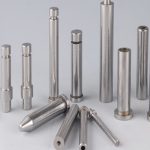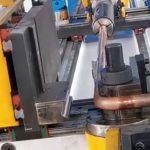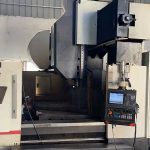Control Of Cone Dimensions Of Lathes
If the taper meets the requirements and the turning tool clamping is correct, then the diameter of the large and small ends of the cone should be turned to the required size. Therefore, in the turning process of the lathe, it is necessary to detect the diameter of its large and small ends to control the dimensional accuracy of the cone.
1.Measurement of cone diameter dimensions
The diameter of the large and small ends of the cone can be measured with a cone gauge. Cone gauges are divided into plug gauges and sleeve gauges. In addition to having a precise conical surface, they each have a step (scribed line) on the end face. The length m of the lathe step (the distance between the engraved lines) is the tolerance range of the diameter of the large and small ends of the cone.
When inspecting the workpiece, it is qualified when the end face of the workpiece is located between the tapered gauge steps (scribed lines).
2.Control of cone size
- Use a cone gauge to control the size of the cone When the production batch of the cone workpiece is large, the cone gauge can be used to control the size of the large diameter. When turning a taper on a lathe, the taper should be calibrated first, and then checked with a taper gauge. The distance from the workpiece end face of the lathe to the center of the gauge step (or engraved line) is . , according to n, the cutting depth n when turning the diameter of the large and small ends can be calculated, so as to accurately turn the cone. Post can be calculated with the following formula ap=atan number=a lead (5-7) where n. ——The depth of cut when the distance from the workpiece end face to the taper gauge step (marked line) is a, rnm; to—the half angle of the cone, (o); c-taper.
- The method of moving the saddle to control the cutting depth When this method is used to control the cutting depth, it is not necessary to calculate the cutting depth, and the cutting depth is not realized by moving the saddle instead of the moving slide. The effect of this method is exactly the same as the previous method of controlling the depth of cut, but this method is only suitable for turning the small slide method to turn the taper or turning the taper hole.
When turning the cone with the small sliding plate method, use the limit set gauge to measure the distance between the small end face and the middle point of the set gauge step. After removing the set gauge, use the small slide plate to advance the turning tool to the point that is just close to the workpiece. It stops advancing when the end-to-end faces are in contact. The lathe then slowly retreats the turning tool in the reverse direction, and measures the distance between the tool tip and the end face of the workpiece while retreating, when this distance is exactly equal to. , stop retracting. Use the longitudinal feed handwheel to move the saddle, so that the tool tip is in contact with the end face of the workpiece, and the cutting depth is adjusted.
In the same way, it is possible to control the depth of cut when turning taper holes.
At Be-cu.com,we use advanced equipment to offer you Unparalleled precision for producing metal and plastic machining parts
- We combine the latest Cnc milling and turning processes with proprietary technology to deliver high quality, on-demand parts.
- Our team of engineers and machinists program the equipment to optimize cutting time, surface finish, and final tolerance to meet your design specifications
- We specialize in cnc precision machining, single part prototyping, short to medium production runs, manufacture parts on time, every time, so you can stay ahead of schedule
- CNC machining can create very similar parts to series parts. It is often more efficient and faster than other rapid prototyping technologies for the manufacture of a quantity of prototypes between 1 and 10 parts . We also recommend CNC machining for parts with large sizes (greater than 600 mm).
Link to this article:Control Of Cone Dimensions Of Lathes
Reprint Statement: If there are no special instructions, all articles on this site are original. Please indicate the source for reprinting:Alloy Wiki,thanks!^^







